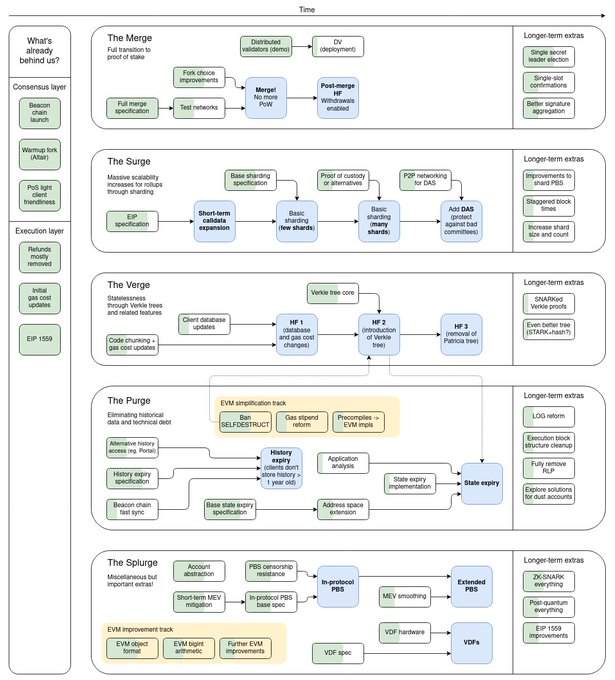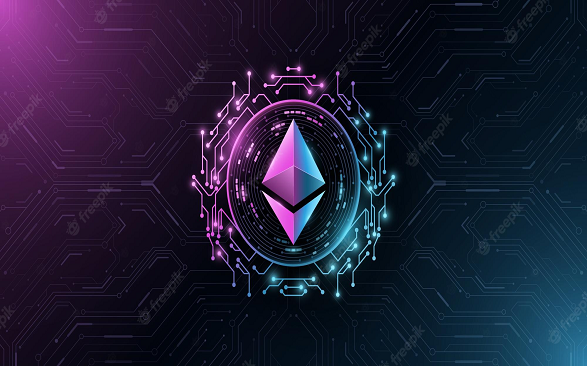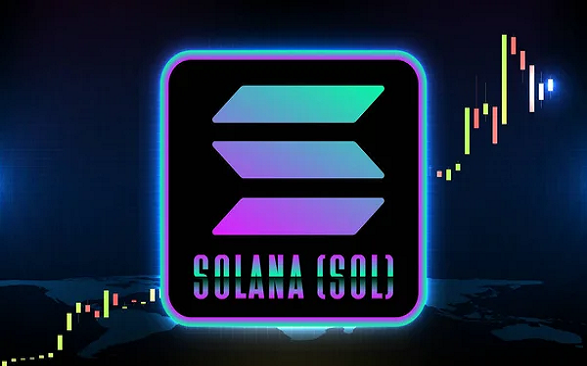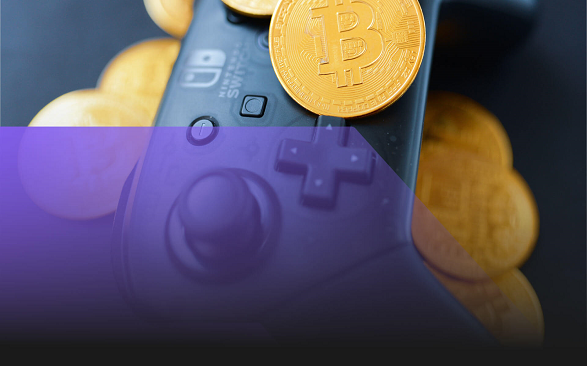“And we finalized! Happy merge all. This is a big moment for the Ethereum ecosystem. Everyone who helped make the merge happen should feel very proud today”- Vitalik Buterin, the founder of Ethereum, after the merge on 15 September 2022
The Ethereum Merge
The Ethereum Merge was a technological event that involved the merge of proof of work (PoW) with the proof of stake (PoS) beacon chain. PoW is an energy-intensive mining process used to verify transactions and secure the network while PoS is an energy-efficient validation process used to verify transactions and secure the network. So basically the merge is simply a change of the consensus mechanism used to verify Ethereum transactions and secure the network.
Originally, the Ethereum blockchain was designed to run using the PoW consensus algorithm mechanism which supports crypto mining. While this mechanism is highly trusted and guarantees network security, it is energy-intensive, less scalable, and expensive to use. Learn more about Ethereum here and here about cryptocurrencies.
Energy consumption has been one of the major criticisms against cryptocurrencies. Initially, the PoW-based Ethereum blockchain consumed so much energy, and some people have argued that cryptocurrencies are killing the planet. This environmental issue has in fact prevented some institutions from taking advantage of the technology and everything it offers. In order to reduce Ethereum’s energy consumption, the Ethereum Foundation decided to move from PoW to the more energy efficient PoS. The Merge is the first stage of the upgrade of the Ethereum blockchain from a computing system that consumes a lot of electricity to a greener and less power-hungry system.
Myths vs. Truths about The Ethereum Merge
1. Reduction of gas fees: The merge basically changes the consensus algorithm from PoW to PoS, thus has nothing to do with gas-fee reduction in the Ethereum network. This is because the merge will not expand the Ethereum network capacity. Gas fees are payments made by users to compensate for the computing energy required to process and validate transactions on the Ethereum blockchain. Ethereum gas fees are mainly determined by the supply and demand for processing power. According to Ethereum.org, the Merge cannot reduce gas fees. It states: “Gas fees are a product of network demand relative to the network’s capacity. The Merge deprecated the use of proof-of-work, transitioning to proof-of-stake for consensus, but did not significantly change any parameters that directly influence network capacity or throughput.”
2. Faster transactions: There will be some slight changes to help transactions happen on the Ethereum network but the transaction speed will largely be the same. When it comes to scalability, the introduction of sharding on Ethereum is expected to achieve this. Sharding is not expected to happen until the Surge which is due in 2023. Sharding will split Ethereum blockchain’s entire network into smaller partitions, known as “shards”, thus significantly increase the network’s scalability.
3. Increase in Ethereum price: The Merge in itself will not directly cause a significant change in Ethereum price. But big events such as this have been known to increase the investment in some coins thereby increasing their values. Because Ethereum still has up to 4 more steps to take, an immediate and significant impact on Ethereum price is not expected at this time.
4. Staked ETH can be withdrawn: The Merge will not enable the withdrawal of staked ETH. For now, staked ETH cannot be unstaked or transferred on the Ethereum network until after the Shanghai upgrade, which is part of the roadmap of upgrades to take place on the Ethereum network. Once withdrawals are enabled after the Shanghai upgrade, users will be able to manually unstake their ETH and withdraw. Another important thing to note is that even after the Shanghai upgrade, there will be withdrawal limitations that will prevent validators from withdrawing all staked ETH at once. This is in order to maintain the security of the Ethereum network.
5. Ethereum will no longer be burnt: Ethereum coins are constantly being burned. This is not expected to stop. Up to 2.35 million ETH were burned over the last year. This is done to regulate the amount of supply in the market, and if the burning continues at the same rate, ETH will become deflationary and shrink by 2% per year. By comparison, the current inflation rate is 2%. This figure does not seem very impressive but it is a notable difference in reality. The decrease in supply for the same demand could increase the price, an important benefit of the whole renewal.
6. Ethereum Merge will bring greener energy: Yes, experts believe that PoS is much greener, which fits perfectly into the current ecological mental agenda. PoS reduces up to 99% of negative emissions compared to PoW. This environmental factor is among the top three arguments raised against cryptocurrencies. Switching to PoS will solve the main problem of network sustainability and it will lay the foundations for the project’s future development.
7. Ethereum is now a security: This is presently undetermined. Although the Chairperson of the US Securities and Exchange Commission (SEC), Gary Gensler, has remarked that PoS assets could be securities, he has not specifically commented on Ethereum. While Bitcoin has been considered not to be a security, there is a growing apprehension over the possible classification of post-Merge Ethereum as a security because of the staking now involved. But Coin Centre has argued that the change with validating Ethereum transactions from PoW to PoS should not affect its classification since in “both cases validators are an open set of participants and the only precondition to participation is provably suffering some cost”, not reliance for profits derived primarily from the efforts of others.
8. Ethereum Merge is the Final Step before ‘Moon’: No, Ethereum will not necessarily be mooning, at least not anytime soon. The Merge is only the first of five steps. The Merge will be followed by The Surge, the Verge, the Purge, and the Splurge, altogether set to transform Ethereum to a more efficient and scalable platform. Vitalik Buterin, Ethereum Founder, claims that following the completion of 5 key phases of upgrade, Ethereum will be able to process “100,000 transactions per second”. Currently, the network can handle about 25 to 30 transactions per second.
As stated earlier, the Surge will make Ethereum scalable by introducing sharding. The Verge will help optimize storage on Ethereum and reduce node size. While the Purge will help in reducing the hard drive space needed for validators and consequently reduces network congestion, the Splurge will introduce a series of smaller upgrades which will help ensure that the Ethereum network runs smoothly.
 Source: Miles Deutscher
Source: Miles Deutscher
What does this mean to the crypto asset buyer?
While no outcome is certain, some experts believe that the Merge could be bullish for crypto investors in the long run due to the groundwork it lays for future upgrades on the Ethereum network. Though the Merge does not guarantee this, quicker transactions and lower fees could eventually lead to more users as well, which could affect the value of Ethereum.
Ethereum price dropped below $1,500 Thursday morning in the hours following the completion of the Merge. Pro-PoW supporters of Ethereum are not very excited about the Merge. This appears to be drawing Ethereum back, if it will not break it eventually. Ethereum Classic, the fork of Ethereum, comes to mind here. Along with the Ethereum Merge this week, next week’s Federal Reserve meeting could bring some level of volatility to Ethereum’s price, with another federal interest rate hike expected.
Cryptocurrencies have been moving in tandem with stock markets in recent months, which have had a rough year amid ever-increasing inflation. This has shaken investor confidence, led to rising interest rates, and recession fears. But analysts believe that the crypto winter season will soon be over and the bullish trend will come. Since the changes coming to Ethereum are in 5 stages, it appears to favor the mid-term and long-term investors more. Whatever you decide to do, apply crypto investment risk management.
Discover more from Crypto Asset Buyer
Subscribe to get the latest posts sent to your email.





2 Comments
Mrs+Ejike
Thank you for this info
Comments are closed.